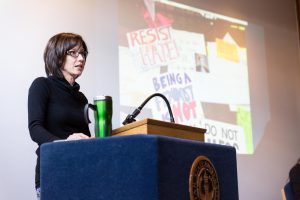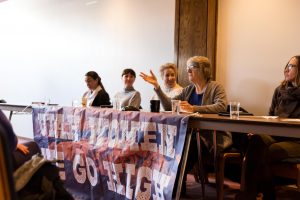USU faculty share experiences from Women’s March on Washington

They went, they marched and they returned to share their experiences of a movement that was likely the largest coordinated protest in world history.
The Center for Women and Gender hosted a panel discussion on Monday featuring several Utah State University women who traveled to Washington, D.C. for the Women’s March on Washington during inauguration weekend, as well as a USU woman who participated in the Park City sister march.
“We are speaking as individuals, not as students or faculty, although we are students and faculty,” said Christy Glass, a professor of sociology.
The distinction is important because none of the women speak officially for USU. However, the women agreed their messages were too important to remain silent.
“This is not a moment, it is a movement,” said Marissa Vigneault, an assistant professor of art history. “We can’t stand back and censor right now.”
The march covered a wide variety of issues.
“I saw marchers identified by their religions, or by their race or ethnicity, or by the issues they cared about — the environment and climate change, protecting immigrants, anti-war, black lives matter, pro-education, etc.,” said Nancy Mesner, a professor of watershed sciences.

“It was amazing to see how diverse the crowd and the crowd’s issues were,” she said.
About 470,000 people attended the Women’s March on Washington, The New York Times reported.
The crowd was like “rivers of people marching past,” Mesner said.
Protesters marched of their own volition from the demonstration site, even though the march was officially canceled because of the size of the crowd.
“It just kind of flowed naturally to the White House,” said Mesner.
“We were like water — there was just too many of us to stop,” said Laura Gelfand, a professor of art history.
The march was overall peaceful, positive and inclusive in gender, nationality and sexual orientation, according to panelists, although some panelists were concerned that the heavy emphasis on reproductive rights may have discouraged anti-abortion feminists.
“The march was an amazing experience in so many ways. The overwhelming positivity of the group, the humor and the cleverness of the signs and marchers, the dedication we all had to making sure that our voices were heard, how clearly we all cherish our country and the rights and freedoms that it guarantees to all of us. I don’t think I have ever felt as proud to be an American as I did at the march,” Gelfand said.
“It makes me very positive about what this can continue to be,” said Vigneault, who also called the march “heartening.”
“What surprised me was just how happy it was,” said Mesner. “The diversity of the crowd and the peacefulness and openness of a crowd this size just blew me away.”
An exhibition of photographs and posters from the marches will be on display Feb. 6-10 in the Readymade Gallery of the University Reserve building (next to Fine Arts building).
— joshua.hortin@aggiemail.usu.edu
Photos by Kyle Todecheene

